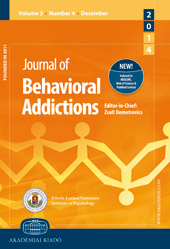Detecting associations between behavioral addictions and dopamine agonists in the Food & Drug Administration’s Adverse Event database
Detecting associations between behavioral addictions and dopamine agonists in the Food & Drug Administration’s Adverse Event database
Author(s): Katherine E. Gendreau, Marc N. PotenzaSubject(s): Psychology, Neuropsychology, Clinical psychology, Behaviorism, Substance abuse and addiction, Health and medicine and law
Published by: Akadémiai Kiadó
Keywords: behavioral addictions; impulse control disorders; Parkinson’s disease; dopamine agonists; pharmacovigilance; FAERS;
Summary/Abstract: Studies have reported higher prevalences of four behavioral addictions (binge eating, compulsive shopping, hypersexuality, and pathological gambling) in dopamine agonist-treated Parkinson’s disease relative to non-dopamine agonist-treated Parkinson’s. However, recent case-control and epidemiological studies suggest that prevalences of behavioral addictions in dopamine agonist-treated Parkinson’s may be similar to background population rates. This study tests that hypothesis by examining the FDA Adverse Event Reporting System (FAERS) for evidence of these associations, taking into account the potential impact of publicity on reporting rates. Methods: FAERS reports in 2004 (pre-publicity for all but pathological gambling) and 2007 (post-publicity for all four behaviors) were analyzed. A threshold consisting of ³3 cases, proportional reporting ratio ³2, and c2 with Yates’ correction ³4 was used to detect signals (drug-associated adverse reactions) involving any of five dopamine agonists and any of four behavioral addictions. Results: No reports containing compulsive shopping and no signal for binge eating and dopamine agonists were found in either year. A weak signal was found for hypersexuality in 2004, with a stronger signal in 2007. A robust signal was found for pathological gambling in 2004, with a more robust signal in 2007. Discussion/Conclusions: These results suggest that publicity may increase reporting rates in the FAERS. Findings for binge eating, compulsive shopping, and hypersexuality suggest that prevalences of these behaviors among those treated with dopamine agonists may be similar to background population rates and thus may not reflect an adverse safety signal. Further investigation of the relationship between dopamine agonists and behavioral addictions is warranted.
Journal: Journal of Behavioral Addictions
- Issue Year: 3/2014
- Issue No: 1
- Page Range: 21-26
- Page Count: 6
- Language: English

